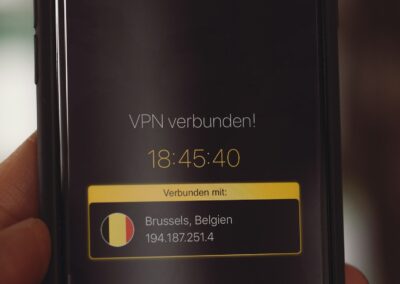Preventing Data Interception in IoT Communications
The Importance of Encryption in IoT Security
Effective encryption in IoT device-to-device communication is crucial for preventing data interception and ensuring the security of interconnected devices. As the number of IoT devices continues to grow, so does the potential for cyber threats. These devices often transmit sensitive data, making them attractive targets for malicious actors. Without robust encryption, data transmitted between IoT devices can be intercepted, manipulated, or stolen, leading to significant security breaches.
In regions such as Saudi Arabia and the UAE, where technological innovation is driving economic growth, the security of IoT communications is of paramount importance. Cities like Riyadh and Dubai are at the forefront of adopting smart technologies, making the protection of data transmitted between IoT devices critical. Encryption provides a powerful solution to these challenges by ensuring that data remains secure and confidential during transmission.
Encryption converts data into a format that can only be read by authorized parties, preventing unauthorized access. This process is essential for protecting sensitive information and maintaining the integrity of IoT systems. By implementing strong encryption protocols, businesses in Riyadh and Dubai can safeguard their IoT communications, protecting both their data and their reputation in the process.
Implementing Strong Encryption Protocols
To effectively secure IoT device-to-device communication, it is essential to implement strong encryption protocols. These protocols ensure that data transmitted between devices is protected from interception and tampering. One widely used protocol is the Advanced Encryption Standard (AES), which provides robust encryption and is suitable for a wide range of IoT applications. AES-256, in particular, offers a high level of security, making it an ideal choice for protecting sensitive data.
In Saudi Arabia and the UAE, where data security is a top priority, adopting strong encryption protocols like AES-256 can significantly enhance the security of IoT systems. Additionally, the Transport Layer Security (TLS) protocol is commonly used to secure data transmitted over networks. TLS provides end-to-end encryption, ensuring that data remains confidential and secure from the moment it leaves one device until it reaches its destination.
Another important protocol for securing IoT communications is the Datagram Transport Layer Security (DTLS) protocol. DTLS is designed for securing datagram-based applications, making it suitable for IoT devices that rely on UDP for communication. By implementing DTLS, businesses can ensure that their IoT devices are protected against data interception and other cyber threats. In tech-forward cities like Riyadh and Dubai, leveraging these encryption protocols is essential for maintaining the security and integrity of IoT systems.
Leveraging AI and Blockchain for Enhanced Security
Artificial Intelligence (AI) and blockchain technology offer innovative solutions for enhancing the security of IoT device-to-device communication. AI can help identify and mitigate security vulnerabilities by analyzing data traffic in real-time, detecting anomalies, and providing automated recommendations for improvements. Machine learning algorithms can also predict potential security threats based on historical data, enabling proactive measures to be implemented.
In the dynamic technological landscapes of Riyadh and Dubai, leveraging AI for secure IoT communications can significantly enhance the robustness of connected systems. AI-driven security tools can continuously monitor IoT interactions, ensuring that any unusual activity is promptly identified and addressed. This proactive approach to security ensures that IoT devices remain protected against evolving cyber threats, maintaining the integrity and reliability of connected systems.
Blockchain technology offers an additional layer of security by providing a decentralized and immutable ledger for recording IoT interactions. This ensures that data transmitted between IoT devices remains secure and tamper-proof. In regions like Saudi Arabia and the UAE, where data integrity is crucial, integrating blockchain into IoT security protocols can provide a secure foundation for protecting sensitive information. Blockchain’s transparency and decentralization make it an effective tool for ensuring the authenticity and integrity of IoT communications.
Protocols for Secure Device Pairing in IoT
Bluetooth Low Energy (BLE) and Secure Simple Pairing
Bluetooth Low Energy (BLE) is a widely used protocol for IoT device-to-device communication, offering low power consumption and robust security features. Secure Simple Pairing (SSP) is a key component of BLE, providing a secure method for pairing devices. SSP uses a combination of public key cryptography and out-of-band authentication to ensure that devices are securely paired without exposing them to potential attacks.
In regions like Riyadh and Dubai, where IoT adoption is rapidly increasing, implementing BLE with SSP can significantly enhance the security of device pairing. By using public key cryptography, SSP ensures that only authorized devices can establish a connection, preventing unauthorized access. Additionally, the out-of-band authentication method provides an extra layer of security, ensuring that pairing data cannot be intercepted or manipulated.
Businesses in Saudi Arabia and the UAE can benefit from the security features of BLE and SSP by ensuring that their IoT devices are securely paired and protected from cyber threats. By adopting these protocols, organizations can enhance the security of their IoT ecosystems, protecting sensitive data and maintaining user trust.
Wi-Fi Protected Access (WPA3) and Enhanced Security
Wi-Fi Protected Access (WPA3) is the latest standard for Wi-Fi security, offering enhanced protection for IoT devices. WPA3 introduces several improvements over its predecessor, WPA2, including stronger encryption, protection against brute-force attacks, and simplified security configuration. These features make WPA3 an ideal choice for securing Wi-Fi-enabled IoT devices.
In tech-forward cities like Riyadh and Dubai, where Wi-Fi is widely used for IoT communication, adopting WPA3 can significantly enhance the security of connected devices. WPA3’s robust encryption ensures that data transmitted over Wi-Fi networks remains secure and confidential. Additionally, the protocol’s protection against brute-force attacks prevents unauthorized access, ensuring that only authorized devices can connect to the network.
Businesses in Saudi Arabia and the UAE can leverage WPA3 to protect their IoT devices from cyber threats, enhancing the overall security of their IoT ecosystems. By adopting this latest Wi-Fi security standard, organizations can ensure that their IoT communications remain secure, even as cyber threats become more sophisticated.
Near Field Communication (NFC) and Secure Pairing
Near Field Communication (NFC) is another protocol commonly used for secure IoT device pairing. NFC allows devices to establish a connection by simply being in close proximity to each other, reducing the risk of interception. The protocol uses secure channels to transmit pairing data, ensuring that it remains protected from potential attacks.
In regions like Saudi Arabia and the UAE, where the adoption of contactless technologies is growing, NFC provides a convenient and secure method for pairing IoT devices. The protocol’s close-range communication minimizes the risk of unauthorized access, ensuring that only devices in physical proximity can establish a connection. Additionally, NFC’s secure channels protect pairing data, preventing it from being intercepted or manipulated.
Businesses in Riyadh and Dubai can benefit from the security features of NFC by adopting it for IoT device pairing. By leveraging NFC, organizations can ensure that their IoT devices are securely paired, protecting sensitive data and maintaining the integrity of their connected systems.
Conclusion
Adopting encryption in IoT device-to-device communication is essential for preventing data interception and ensuring the security of interconnected systems. By leveraging strong encryption protocols, implementing secure device pairing methods, and integrating AI and blockchain technologies, businesses in Saudi Arabia, the UAE, Riyadh, and Dubai can enhance the security of their IoT ecosystems. Embracing these practices will enable organizations to harness the full potential of IoT, driving innovation, operational efficiency, and long-term business success in an increasingly connected world.
—
#EncryptionInIoT #SecureDevicePairing #IoTCommunicationSecurity #DataInterceptionPrevention #SaudiArabiaTechnology #UAEInnovation #AIInIoTSecurity #BlockchainForDataProtection #BusinessSuccess #ExecutiveCoaching #LeadershipInTechnology #ProjectManagement































